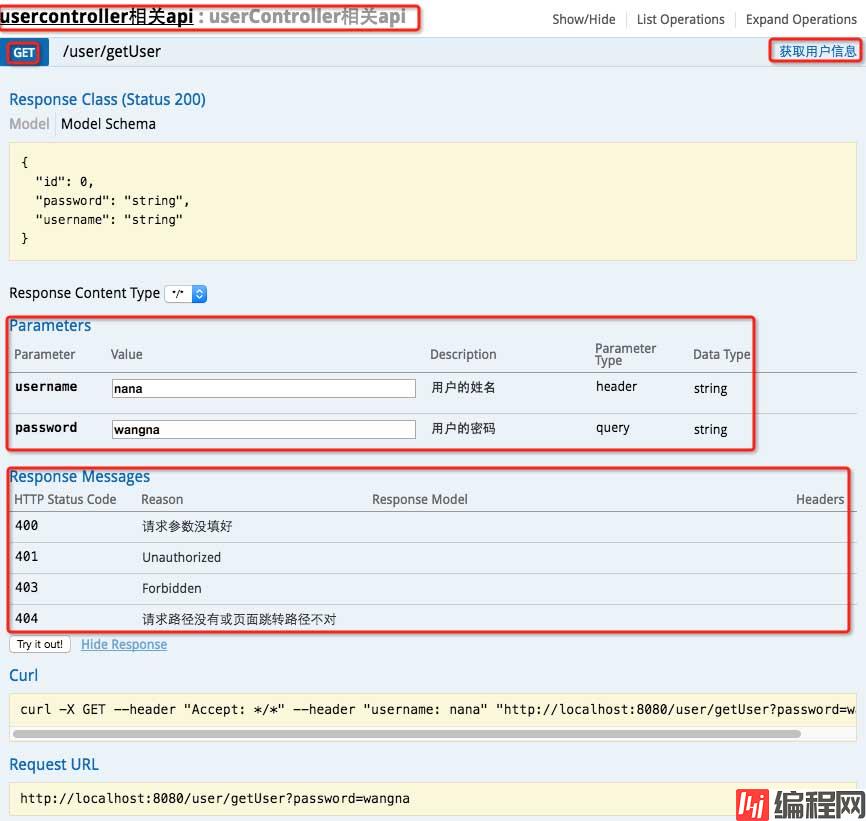Python 官方文档:入门教程 => 点击学习
目录@apiImplicitParam参数类型 作用@ApiImplicitParamsparamType 示例详解小结一下测试@ApiImplicitParam 作用在方法上,表示
作用在方法上,表示单独的请求参数
name:参数名。value:参数的具体意义,作用。required:参数是否必填。dataType:参数的数据类型。paramType:查询参数类型,这里有几种形式:path 以地址的形式提交数据query 直接跟参数完成自动映射赋值body 以流的形式提交 仅支持POSTheader 参数在request headers 里边提交fORM 以form表单的形式提交 仅支持POST在这里我被坑过一次:当我发POST请求的时候,当时接受的整个参数,不论我用body还是query,后台都会报Body Missing错误。
这个参数和springMVC中的@RequestBody冲突,索性我就去掉了paramType,对接口测试并没有影响。
用于方法,包含多个 @ApiImplicitParam:
例:
@Apioperation("查询测试")
@GetMapping("select")
//@ApiImplicitParam(name="name",value="用户名",dataType="String", paramType = "query")
@ApiImplicitParams({
@ApiImplicitParam(name="name",value="用户名",dataType="string", paramType = "query",example="xingguo"),
@ApiImplicitParam(name="id",value="用户id",dataType="long", paramType = "query")})
public void select(){
}path
@RequestMapping(value = "/findById1/{id}", method = RequestMethod.GET, produces = MediaType.APPLICATION_JSON_UTF8_VALUE)
@PathVariable(name = "id") Long id
body
@ApiImplicitParams({ @ApiImplicitParam(paramType = "body", dataType = "MessageParam", name = "param", value = "信息参数", required = true) })
@RequestMapping(value = "/findById3", method = RequestMethod.POST, produces = MediaType.APPLICATION_jsON_UTF8_VALUE, consumes = MediaType.APPLICATION_JSON_VALUE)
@RequestBody MessageParam param
提交的参数是这个对象的一个json,然后会自动解析到对应的字段上去,也可以通过流的形式接收当前的请求数据,但是这个和上面的接收方式仅能使用一个(用@RequestBody之后流就会关闭了)
header
@ApiImplicitParams({ @ApiImplicitParam(paramType = "header", dataType = "Long", name = "id", value = "信息id", required = true) })
String idstr = request.getHeader("id");
if (StringUtils.isNumeric(idstr)) {
id = Long.parseLong(idstr);
}
Form
@ApiImplicitParams({ @ApiImplicitParam(paramType = "form", dataType = "Long", name = "id", value = "信息id", required = true) })
@RequestMapping(value = "/findById5", method = RequestMethod.POST, produces = MediaType.APPLICATION_JSON_UTF8_VALUE, consumes = MediaType.APPLICATION_FORM_URLENCODED_VALUE)(1)对于@ApiImplicitParam的paramType:query、form域中的值需要使用@RequestParam获取, header域中的值需要使用@RequestHeader来获取,path域中的值需要使用@PathVariable来获取,body域中的值使用@RequestBody来获取,否则可能出错;而且如果paramType是body,name就不能是body,否则有问题,与官方文档中的“If paramType is "body", the name should be "body"不符。
@ApiImplicitParams:用在方法上包含一组参数说明@ApiImplicitParam:用在@ApiImplicitParams注解中,指定一个请求参数的各个方面paramType:参数放在哪个地方header-->请求参数的获取:@RequestHeaderquery-->请求参数的获取:@RequestParampath(用于restful接口)-->请求参数的获取:@PathVariablebody(不常用)form(不常用)name:参数名dataType:参数类型required:参数是否必须传value:参数的意思defaultValue:参数的默认值@ApiResponses:用于表示一组响应@ApiResponse:用在@ApiResponses中,一般用于表达一个错误的响应信息code:数字,例如400message:信息,例如"请求参数没填好"response:抛出异常的类
import org.springframework.beans.factory.annotation.Autowired;
import org.springframework.WEB.bind.annotation.RequestHeader;
import org.springframework.web.bind.annotation.RequestMapping;
import org.springframework.web.bind.annotation.RequestMethod;
import org.springframework.web.bind.annotation.RequestParam;
import org.springframework.web.bind.annotation.RestController;
import io.swagger.annotations.Api;
import io.swagger.annotations.ApiImplicitParam;
import io.swagger.annotations.ApiImplicitParams;
import io.swagger.annotations.ApiOperation;
import io.swagger.annotations.ApiResponse;
import io.swagger.annotations.ApiResponses;
@RestController
@RequestMapping("/user")
@Api("userController相关api")
public class UserController {
@Autowired
private UserService userService;
@ApiOperation("获取用户信息")
@ApiImplicitParams({
@ApiImplicitParam(paramType="header",name="username",dataType="String",required=true,value="用户的姓名",defaultValue="zhaojigang"),
@ApiImplicitParam(paramType="query",name="passWord",dataType="String",required=true,value="用户的密码",defaultValue="wangna")
})
@ApiResponses({
@ApiResponse(code=400,message="请求参数没填好"),
@ApiResponse(code=404,message="请求路径没有或页面跳转路径不对")
})
@RequestMapping(value="/getUser",method=RequestMethod.GET)
public User getUser(@RequestHeader("username") String username, @RequestParam("password") String password) {
return userService.getUser(username,password);
}
}启动服务,浏览器输入"Http://localhost:8080/swagger-ui.html"

在上面案例中我们可以知道如果在request域中我们使用reques.getHeader()和使用@RequestHeader注解作用是一样的,其它内容类似。
@ApiResponses:用于表示一组响应@ApiResponse:用在@ApiResponses中,一般用于表达一个错误的响应信息code:数字,例如400message:信息,例如”请求参数没填好”response:抛出异常的类
@ApiOperation("获取用户信息")
@ApiImplicitParams({@ApiImplicitParam(paramType="header",name="name",dataType="String",required=true,value="用户的姓名",defaultValue="zhaojigang"),
@ApiImplicitParam(paramType="query",name="pwd",dataType="String",required=true,value="用户的密码",defaultValue="wangna")
})
@ApiResponses({ @ApiResponse(code=400,message="请求参数没填好"),
@ApiResponse(code=404,message="请求路径没有或页面跳转路径不对")
})
@RequestMapping(value="/getUser",method= RequestMethod.GET)
public User getUser(@RequestHeader("name") String name,@RequestParam("pwd") String pwd) {
System.out.println(name);
System.out.println(pwd);
return userRepository.getUserByNameAndPwd(name,pwd);
}以上为个人经验,希望能给大家一个参考,也希望大家多多支持编程网。
--结束END--
本文标题: 关于@ApiImplicitParams、ApiImplicitParam的使用说明
本文链接: https://www.lsjlt.com/news/155229.html(转载时请注明来源链接)
有问题或投稿请发送至: 邮箱/279061341@qq.com QQ/279061341
下载Word文档到电脑,方便收藏和打印~
2024-03-01
2024-03-01
2024-03-01
2024-02-29
2024-02-29
2024-02-29
2024-02-29
2024-02-29
2024-02-29
2024-02-29
回答
回答
回答
回答
回答
回答
回答
回答
回答
回答
0